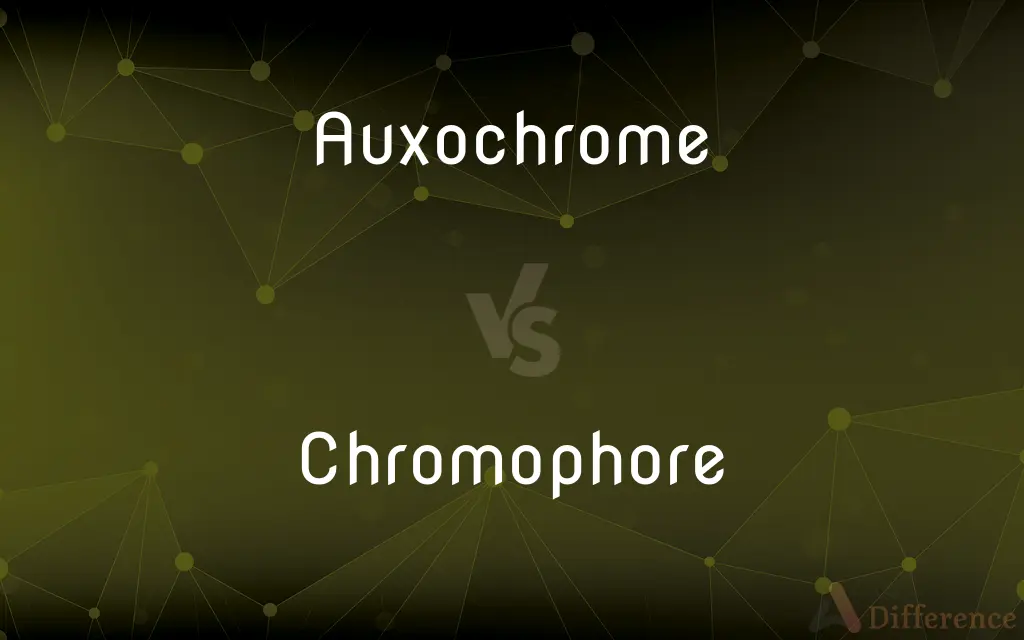Auxochrome vs. Chromophore — What's the Difference?
Edited by Tayyaba Rehman — By Fiza Rafique — Updated on October 5, 2023
"Chromophore" is the part of a molecule responsible for its color, while "auxochrome" is a group that, when attached, alters the color or intensity of that color.

Difference Between Auxochrome and Chromophore
Table of Contents
ADVERTISEMENT
Key Differences
At the core of molecular coloration, the "chromophore" acts as the central entity. It absorbs specific wavelengths of light, resulting in coloration. The "auxochrome," however, works in conjunction with the chromophore. Though not innately colorful, when connected to a chromophore, it can either intensify the color or shift its wavelength, thereby changing the color observed.
"Chromophores" are integral to a molecule's ability to absorb certain light wavelengths. They define the inherent coloration of a molecule. "Auxochromes," on the other hand, serve a supportive role. Their main function isn't to color the molecule but to modify the color exhibited by the chromophore.
When a "chromophore" absorbs light, electrons transition between energy levels, leading to the perception of color. The presence of an "auxochrome" can modify the energy difference between these levels. This results in the absorption of light at different wavelengths, effectively changing the color that's observed.
In the realm of dyes and pigments, the role of the "chromophore" is pivotal, determining the base coloration. Introducing an "auxochrome" to the mix can make the color more vibrant or alter its hue. For example, the basic structure of a dye might be colorless, but the addition of a chromophore imparts color, and the further addition of an auxochrome intensifies or adjusts this color.
Understanding the interplay between "chromophores" and "auxochromes" is essential in fields like textile design, where precise color adjustments are crucial. By manipulating the presence and type of auxochromes, scientists and designers can fine-tune the shades and tints of dyes and other colorant molecules.
ADVERTISEMENT
Comparison Chart
Function
Modifies or intensifies color
Responsible for the color
Nature
Supportive to chromophore
Central to coloration
Presence in Molecules
Not inherently colorful but affects the chromophore's coloration
Inherently responsible for the molecule's color
Role in Dyes
Can shift or intensify the color of dyes
Determines the base coloration of dyes
Chemical Interaction
Alters the energy levels of electrons in the chromophore
Absorbs light at specific wavelengths, causing coloration
Compare with Definitions
Auxochrome
A molecule segment that shifts the light absorption of a chromophore.
The presence of an auxochrome altered the hue of the dye solution.
Chromophore
A part of a molecule that determines the color of the molecule.
Removing the chromophore resulted in a colorless solution.
Auxochrome
A substituent group that enhances the color intensity of a chromophore.
When an auxochrome was added to the dye, the color became much richer.
Chromophore
The segment of a molecule responsible for its light-absorbing properties.
The chemical's UV absorption was due to its chromophore.
Auxochrome
A non-chromophoric group influencing a chromophore's spectral properties.
The auxochrome significantly changed the spectral characteristics of the molecule.
Chromophore
A molecular fragment that causes a compound to be colored by absorbing specific wavelengths of light.
The presence of the chromophore gave the chemical its vibrant red hue.
Auxochrome
An atom or group in dyes that can intensify or modify the chromophore's color.
Incorporating the auxochrome resulted in a change in the shade of blue of the fabric.
Chromophore
An atom or group whose presence brings color to organic compounds.
The compound's green shade could be attributed to its chromophore.
Auxochrome
A molecular adjunct that affects the wavelength at which a chromophore absorbs light.
The auxochrome caused the dye to absorb light at a slightly longer wavelength.
Chromophore
The active center in a molecule causing visible color or fluorescence.
The fluorescence of the substance was activated by the chromophore.
Auxochrome
An auxochrome (from Ancient Greek αὐξάνω auxanō "increase" and χρῶμα chrōma "colour") is a group of atoms attached to a chromophore which modifies the ability of that chromophore to absorb light. They themselves fail to produce the colour; but when present along with the chromophores in an organic compound intensifies the colour of the chromogen.
Chromophore
A chromophore is the part of a molecule responsible for its color. The color that is seen by our eyes is the one not absorbed by the reflecting object within a certain wavelength spectrum of visible light.
Auxochrome
Any atom or group which, when added to a chromophore, causes a bathochromic shift in its spectrum
Chromophore
Any of various chemical groups that absorb light of certain wavelengths and when present in an organic compound, such as a dye or pigment, are responsible for the color of the compound.
Chromophore
(chemistry) that part of the molecule of a dye responsible for its colour
Chromophore
(chemistry) (more generally) the group of atoms in a molecule in which the electronic transition responsible for a given spectral band is located
Chromophore
Any chemical group or residue (as NO2; N2; or O2) which imparts some decided color to the compound of which it is an ingredient.
Chromophore
The chemical group that gives color to a molecule
Common Curiosities
Is a molecule with a chromophore always colorful?
Typically, yes. Molecules with chromophores absorb light at certain wavelengths, leading to color perception.
How does a chromophore affect the properties of a molecule?
A chromophore absorbs light at specific wavelengths, leading to the perception of color in a molecule.
Can an auxochrome impart color on its own?
No, an auxochrome by itself doesn't impart color but modifies or intensifies the color of a chromophore.
What is the primary function of a chromophore?
The primary function of a chromophore is to absorb specific wavelengths of light, resulting in color.
Why are auxochromes significant in dye manufacturing?
Auxochromes can modify or intensify the color of dyes, allowing for fine-tuning of shades and hues.
Can one molecule have multiple auxochromes or chromophores?
Yes, a molecule can possess multiple auxochromes or chromophores, influencing its spectral properties.
Can the presence of an auxochrome change the color of a compound?
Yes, an auxochrome can shift the absorption wavelength of a chromophore, thereby altering the color.
What happens when an auxochrome is removed from a molecule?
Removing an auxochrome might reduce the color intensity or alter the hue of the molecule.
Are chromophores always organic in nature?
While commonly associated with organic compounds, chromophores can also be present in inorganic substances.
How do chromophores relate to fluorescence?
Chromophores can cause fluorescence when they re-emit light after absorbing it at a specific wavelength.
Are chromophores responsible for the color in all substances?
Chromophores are responsible for color in many substances, but other factors like particle size can also influence color.
Why is understanding chromophores vital in the textile industry?
Chromophores determine the base color of dyes, crucial for producing textiles with desired colors.
Do auxochromes influence the fluorescence of a molecule?
Auxochromes can influence the fluorescence by modifying the chromophore's light-absorbing properties.
Are chromophores only found in dyes?
No, chromophores are found in various substances, including dyes, but also in nature, like in plants and animals.
Can the addition of an auxochrome make a colorless compound colorful?
An auxochrome can make a colorless compound colorful if it's introduced alongside a chromophore.
Share Your Discovery

Previous Comparison
Worldwide vs. International
Next Comparison
Pasty vs. BridieAuthor Spotlight
Written by
Fiza RafiqueFiza Rafique is a skilled content writer at AskDifference.com, where she meticulously refines and enhances written pieces. Drawing from her vast editorial expertise, Fiza ensures clarity, accuracy, and precision in every article. Passionate about language, she continually seeks to elevate the quality of content for readers worldwide.
Edited by
Tayyaba RehmanTayyaba Rehman is a distinguished writer, currently serving as a primary contributor to askdifference.com. As a researcher in semantics and etymology, Tayyaba's passion for the complexity of languages and their distinctions has found a perfect home on the platform. Tayyaba delves into the intricacies of language, distinguishing between commonly confused words and phrases, thereby providing clarity for readers worldwide.














































